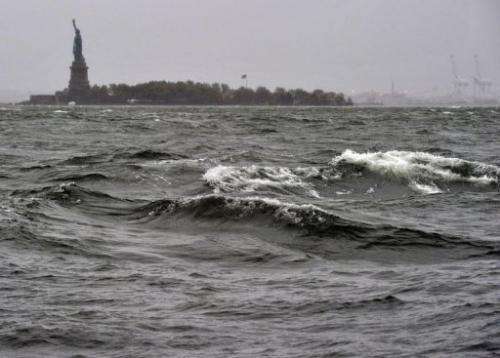US data, telecom networks face storm test

Hurricane Sandy's assault on the eastern United States is a major test of the key data and telecom networks that are needed to keep information flowing during such crises.
The arrival of the massive storm comes amid lingering questions about the reliability of data centers after a series of power outages caused major problems earlier this year.
"This super-storm will test the preparations of all the networks," said independent technology analyst Jeff Kagan.
"Every carrier has lived through many different weather problems like hurricanes and have improved over time... but whether it will be enough is the question."
Major telecom carriers had reported no major problems by mid-afternoon Monday, but were bracing for the worst.
Verizon said in a Twitter message at 2100 GMT, "All systems & networks are operating normally, and we've implemented add'l preparations for Sandy."
Sprint said it was mobilizing a "disaster recovery" team and instituting flood prevention measures at network facilities and retail stores.
More significant may be how data centers hold up in the storm. If these centers lose power, it could mean a loss of access for items stored in the Internet "cloud," everything from music files to payrolls to military documents.
Already, earlier this year, outages at Amazon data centers have taken down websites such as Netflix and Reddit.
And because increasing amounts of corporate and government data are now stored in cloud-sharing sites, analysts will be watching to see how data centers withstand the crisis.
Akshay Sharma, an analyst who follows data networks for Gartner Inc, said the systems should hold up if they are engineered correctly.
"Bad things can happen but it's usually just a matter of minutes or hours before things get squared away," he said.
But Sharma said that if there are design flaws, the systems may lack the backup needed for multiple outages, or may open up vulnerabilities to denial of service attacks.
One major cloud storage firm, Nirvanix, announced that it was activating its disaster plan to allow customers using its New Jersey data center to move their data to another location.
"Currently all of the data in Nirvanix's Node 4 data center in New Jersey is secure and all services remain normal and available," the company said.
"However, for those customers seeking extra peace of mind, Nirvanix is enabling them to select where they would like their data to specifically reside, at no additional cost."
Amazon Web Services, which hosts a number of websites as well as government cloud data and which suffered high-profile outages this year, said on its "dashboard" that all its US centers were operating normally as of 2000 GMT.
"We are monitoring Hurricane Sandy and making all possible preparations (e.g. generator fuel, food/water, flashlights, radios, extra staff) in our US East Region," Amazon said.
Cloud and IT firm SunGard said it was on "high alert" and would give updates via Twitter.
Scott Martin of online financial newsletter The Trust Advisor said the move to the cloud allows the finance industry to keep operating in spite of the storm.
"Large organizations can simply shift support work to areas well outside the disrupted zone, allowing work to carry on almost seamlessly," he said.
"If client files are hosted on cloud servers or in redundant data centers—and at this point, it practically amounts to the same scenario—they can access critical data without going near the office, even if the office loses power or floods.
"And as long as the juice holds out, they can even re-route meetings that were scheduled for the office to Facetime, Skype or some other videoconferencing app."
Even though network operators expressed confidence, the Federal Communications Commission urged consumers to avoid taxing the systems.
"Limit non-emergency phone calls," the FCC said in a message to consumers. "This will minimize network congestion, free up 'space' on the network for emergency communications and conserve battery power if you are using a wireless phone."
(c) 2012 AFP



















